|

“If you know them, they'll help you win lots of
games”
All Pawns are of equal value but some Pawns are
more equal than others. Jacopo da Cessole (14th century)
was the first to give the Pawns a name. A Pawn is not
able to reverse
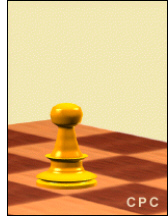 its
move. The letter “P” is sometimes also used to name a
Pawn. The first move option of this minor piece was
introduced in Spain in 1280. Up to the 16th century, a
game could be started by making two minor piece moves
before your opponent moved. This was the norm in Holland
and Germany until the late 19th century. In Asia, Pawns
started on the 3rd rank instead of the 2nd. Until 1903 a
Pawn reaching rank-8 could remain a Pawn! And promotion
could only be to a major piece already captured. If no
major piece had been captured the Pawn remained a Pawn
until a capture occurred. Steinitz was a leading
proponent of the dummy Pawn law. The Pawns get their
name from an old French word meaning foot-soldier and
like the infantry they must advance against the foe. The
Pawns have special rules for their capturing maneuver.
The Pawn is, in fact exceptional in many ways. The
normal move of the Pawn is simple - they plod just one
cell forward at a time. They may never move backwards.
On their first move, however, a Pawn may, if desired, be
moved two cells forward instead of just one. This
privilege is accorded to each of the eight Pawns on
either side, but a Pawn may only advance two cells if
both cells are unoccupied and the Pawn has not
previously been moved. its
move. The letter “P” is sometimes also used to name a
Pawn. The first move option of this minor piece was
introduced in Spain in 1280. Up to the 16th century, a
game could be started by making two minor piece moves
before your opponent moved. This was the norm in Holland
and Germany until the late 19th century. In Asia, Pawns
started on the 3rd rank instead of the 2nd. Until 1903 a
Pawn reaching rank-8 could remain a Pawn! And promotion
could only be to a major piece already captured. If no
major piece had been captured the Pawn remained a Pawn
until a capture occurred. Steinitz was a leading
proponent of the dummy Pawn law. The Pawns get their
name from an old French word meaning foot-soldier and
like the infantry they must advance against the foe. The
Pawns have special rules for their capturing maneuver.
The Pawn is, in fact exceptional in many ways. The
normal move of the Pawn is simple - they plod just one
cell forward at a time. They may never move backwards.
On their first move, however, a Pawn may, if desired, be
moved two cells forward instead of just one. This
privilege is accorded to each of the eight Pawns on
either side, but a Pawn may only advance two cells if
both cells are unoccupied and the Pawn has not
previously been moved.
“The Pawn
movement is the most arduous of the game”
As distinct from their forward mode of travel,
the Pawn captures diagonally, but again only one cell. A
Pawn must move in the file in which it is placed, until
it captures another piece diagonally. It is the only
piece that captures in a different manner to the normal
mode of movement. On reaching rank-8, a Pawn is invested
with the title and assumes the power of any of the major
pieces to which the Pawn is promoted/enrobed to which a
player chooses at his/her discretion.
A Pawn is not permitted to capture any piece which impedes its path and
neither Pawn can do more than remain an obstruction to
the forward march of the other. Upon capturing a
diagonally placed piece, a Pawn changes file i.e., 1.
e4xd5 moves from file-e to file-d. The movements of
these homely Pawns are amongst the most refined and
arduous elements of the game. When placed in front, they
prevent the advance of your opponent's Pawns.
However, you should not place two Pawns abreast until you are able to
support them from behind. If you have two Pawns placed
abreast and one of them is attacked by an opposing Pawn,
you will find it better to advance the Pawn that is
attacked, rather than resort to capture. After castling
King-side, it is better not to advance King-side Pawns
until obliged to do so. Try to protect a Pawn with a
Pawn rather than with a major piece.
Do not advance Pawns on either wing until you see on what side of the
board your opponent castles. In the endgame, two Pawns
can protect themselves against the enemy King.
“The
Arabs called the Pawns foot soldiers”
Promotion is also called enrobing in Chesmayne.
Theoretically, it is possible to have nine Queens. The
Pawn is nearly always promoted to Queen, but
under promotion is also possible. If a Pawn reaches the
top-rank of the board and is promoted to a Queen, then
this Queen is referred to as Queen-2 to distinguish her
from Queen-1. Sometimes it is best to under promote to a
Knight, Bishop, Rook.
The Arabs called them Baidaq, foot soldiers,
which was translated into the Anglo-French word 'Poun'. In
the old game (Shatranj), a Bishop could not be promoted
to Queen, but to a “Minister” only. The game-tree of
Chess was, therefore, different from today, for there
was little point in promotion. A Pawn can move forward
only. A Pawn cannot jump. A Pawn is promoted on reaching
the last rank as part of the same turn or move.
The cell on which a Pawn is promoted is normally called the Queening
cell, even if the Pawn is exchanged for a minor or major piece
which is not a Queen. The en passant capture can only be
made by a Pawn on rank-5. The en passant move is
optional, not obligatory. Beginners often find this
difficult, so practice on rank-5 and on the rank-4 for
black. The Pawn can only capture one diagonal cell
forward to their right or left. The Pawn is known by
different names in differing countries:
Chess piece names in
other languages
|
Language |
Piece name |
Game name |
|
English |
Pawn |
Chess |
|
French |
Pion |
Les echecs |
|
German |
Bauer |
Schachspiel |
|
Italian |
Perdone |
Gli scacchi |
|
Spanish |
Peón |
Ajedrez |
|
Portuguese |
Peo |
Xadrez |
|
Russian |
Peshka |
Shahmati |
|
Arabic |
Baidaq |
Ash-shatranj |
|
Latin |
Pedes |
Scaci |
“A Pawn has a maximum of six
moves to the promoting cell”
In an open game or position, the Pawns are fluid,
are able to advance, and many may have already been
exchanged or disposed. In a closed position, the central
Pawns (P-a4 and P-a5) are interlocked in such a way that
they cannot be exchanged. In such positions, both Knights
can become more important because of their ability to
maneuver.
The quickest number of moves of a Pawn from the
initial starting position to the promoting cell is five
moves, i.e.: 1st move P-d4 (moves 2 cells forward), 2nd
move P-d5, 3rd move P-d6, 4th move P-d7, 5th
move P-d8 (Pawn is promoted to Queen). A Pawn has a
maximum of six moves from the initial starting position
to the promoting cell.
During the opening phase, development may be
slowed down by making too many Pawn moves or moving a
Pawn to a wrong cell. Most openings and defences try to
keep the Pawns united, so that they protect one another.
This is important for the middle game and even more
important in the endgame.
Typical Pawn structures:
Doubled
Pawns: These are two Pawns of the same color
residing on the same file. Doubled Pawns usually imply
that
open files are available and in such cases you may be
able to gain useful play on such a file with
both Rooks. A doubled Pawn is not necessarily a
disadvantage, particularly if it is united with another
Pawn.
A doubled Pawn on file-e is the best because it
strengthens the middle Pawns and makes available a file
for a Rook. A doubled Pawn on file-a or file-h is the
least valuable.
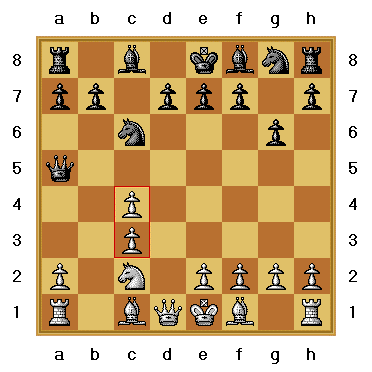
Pawns on c3 and c4 are
doubled Pawns
Isolated Pawns: A Pawn is considered
isolated because there are no Pawns of the same colour
on adjoining files or whose friendly Pawns have left the
adjacent file(s) leaving it on its own, without friendly
Pawn support. If the Pawn is attacked, it may have to be
defended by major pieces which are then left out of
action on other areas of the board.
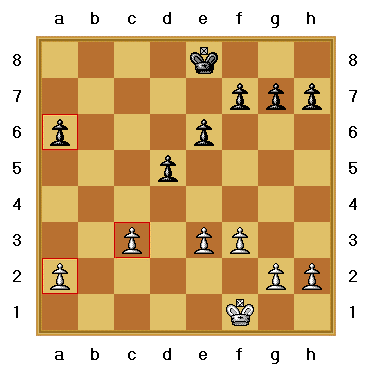
White Pawns a2, c3 and black
Pawn on a6
are isolated Pawns
Backward Pawns: A backward Pawn is a Pawn that is behind all
Pawns of the same color on the adjacent files and cannot
be safely advanced. They're usually in a positional
disadvantage since they are difficult to defend. Also,
the opponent can place a piece, usually a Knight, on the
hole in front of the Pawn without any risk of a Pawn
driving it away.
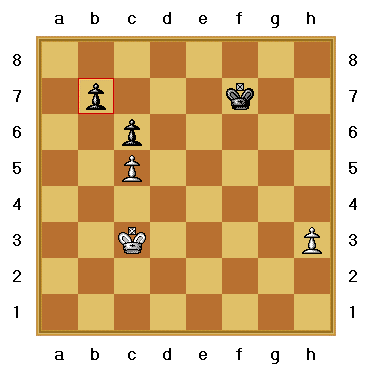
Black Pawn on b7 is a backward Pawn
Passed Pawns: When a Pawn has no enemy Pawn that could
hinder promotion - that is, no enemy Pawn in front or,
on the same file or, either of the next-door files -
then the Pawn is called a passed-Pawn. A passed Pawn in
the endgame can be a great asset, particularly if well
advanced, as the enemy has to use major pieces to stop
the Pawn from becoming a Queen, thus reducing your
adversary's major pieces efficiency.
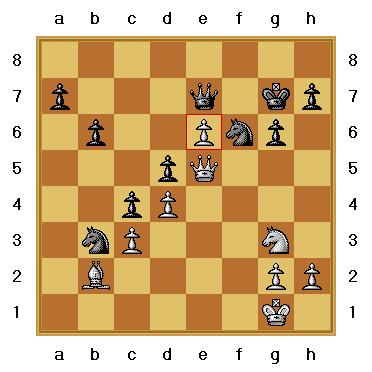
White pawn on e6 is passed
“A Pawn's
value increases as major and minor pieces are exchanged”
In the early stages of the game, the Pawns have
various functions. Those in the center are the most
valuable Pawns and are used for protecting central
cells. Pawns in front of a castled King are used as a
shelter. To wreck this center, the enemy often advances
Pawns upon yours, to force them to advance or exchange.
This operation is called a Pawn-storm. Here, the Pawns
play the part of tanks rather than infantry, although sometimes
they resemble neither tanks nor infantry.
Their lack of mobility makes them more like natural obstructions i.e.,
rivers, hills or marshes, that interfere with mobile
warfare. When one of your own Pawns becomes an
obstruction to your attack, it often pays to sacrifice
the Pawn. A Pawn's value increases as pieces are
exchanged off, for when both armies are so reduced that
checkmate becomes next to impossible, the major
objective becomes the promotion of a Pawn.
To be a Pawn ahead with otherwise as good a position as your opponents,
is usually a winning advantage - theoretically! Although
Pawns are usually promoted into a Queen on reaching
rank-8, they can be also promoted to any other major
piece you choose. In the opening phase the Pawns defend
the center of the board and play a static role. In the
endgame phase, when there are few pieces on the board,
Pawns help the King to capture pieces or to checkmate
your opponent.
In the middle game Pawns become very active. Their function is to drive
away attacks from enemy pieces and move forwards or
sacrifice themselves to open attack lines for the Queen,
Rooks, and Bishops. Pawns that are in a group can
support one another (Pawn islands). Pawns connected in a
chain are quite strong. To attack this chain, your
opponent would need to attack the base Pawn.
Passed Pawns are very strong as they can reach rank-8 without coming into
contact with enemy Pawns on their own or adjacent ranks.
Pawns in enemy territory should ideally be supported by
major pieces. Two Pawns placed on the same rank control
more cells in front but will need to be supported from
behind. A Pawn on rank-7 can even deliver checkmate. A
trailing Pawn should not be left unsupported (backward
Pawn) and if advanced is usually captured quite easily.
Pawns are fixed if they are blocked from moving forward. Isolated Pawns
cannot be defended by neighborly Pawns and are easily
captured by your opponent. Doubled Pawns are weak as the
back Pawn cannot advance until the front Pawn moves
forward. Tripled Pawns are even weaker as the back Pawn
has to wait for the front two Pawns to advance before it
can do so. Hanging Pawns must rely on major pieces for
protection and without support are easily eliminated /
erased.
On it's first move, a Pawn may move either one square forwards or two
squares forwards. After its first move it can only move
forwards one square at a time. Unlike other pieces,
Pawns do not capture in the same way that they move.
They capture one square diagonally forwards. You might
think a Pawn's not much use but there is one really
special thing it can do. If you get a Pawn to the far
side of the board you must exchange it for another
piece: a Queen, a Rook, a Bishop or a Knight.
En Passant
There's another special rule to do with Pawns which
you'll probably find hard to understand. It's called the
en passant rule. If you have a Pawn on your fifth
rank, as white does in fig. 1, and your opponent moves a
Pawn on the next file two squares, you can, on your next
move, capture it as if it had moved one square only as
shown in fig. 2.
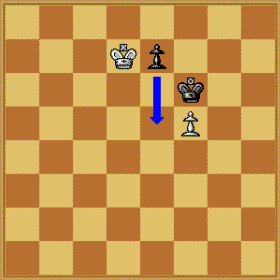 |
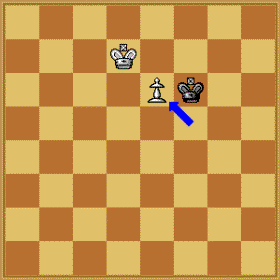 |
| Fig. 1 |
Fig. 2 |
Pawn majorities
If you have a Pawn majority -
say, four Pawns to your opponent's three on one side of the
board -, you should be able to create a passed Pawn. By advancing
the Pawn, you should be able to create enough pressure to win.
Steinitz was the first great exploiter of Pawn majorities, particularly
on the Queen's side where they can often advance without fear of
exposing the King. Some people regard the Queen's side majority
as an advantage in itself, but realistically it depends on where
and what the other pieces are.
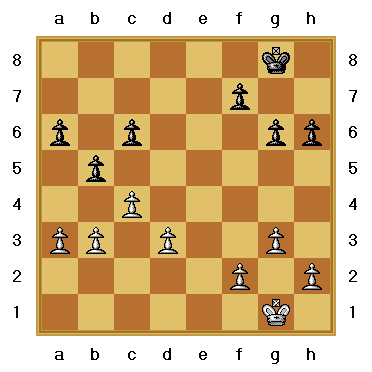
White has a clear Pawn majority
Stalemate: The
game's over but nobody won, what's going on here?
Stalemate is one of the more
confusing concepts to beginners. Stalemate is a case in which
neither side wins the game but it is declared a draw. By the
laws of Chess, you must play a move when it is your turn. Unlike
other games, you are not allowed to pass your move. But what
happens if you don't have any legal moves?
That's where the stalemate rule comes into play. You have no legal moves,
but by the laws of Chess, you have to play a move. The position
is declared as stalemate and the game is drawn. There are also
many more ways (other than stalemate) to draw a game. Draws are
explained in much more detail
here.
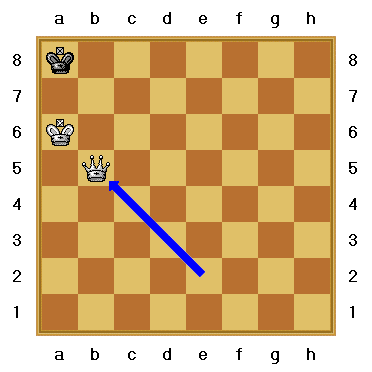
The black King has no
safe square to go
Zugzwang: Zug-what?
Why couldn't they just use English? This one is a German word and
it's a little more complicated than a lot of things that
you've done so far. The word means 'compulsion to move'
and it doesn't happen very often. A zugzwang position is
one in which it is your turn to move but any move that you
make will make your position worse. The term zugzwang was used
in German Chess literature in 1858 or earlier.
The first known use of the term in English was by world champion Emanuel
Lasker in 1905. The concept of zugzwang was known to
players many centuries before the term was coined,
appearing in an endgame study published in 1604 by
Alessandro Salvio, one of the first writers on the game,
and in shatranj studies dating back to the early 9th
century, over 1000 years before the first known use of
the term.
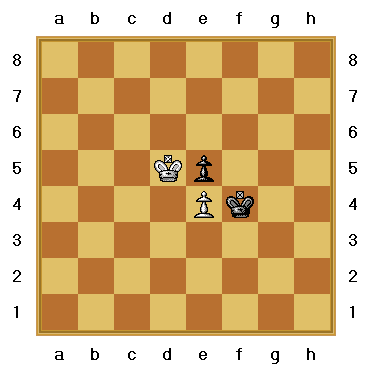
Either player to move,
ends up on
zugzwang
Pawn
Promotion
The Pawn, not even good enough to be called a
piece. They're not very interesting, look kind of boring
and they can only move forward. Something had to be done
to spice these pieces up. A Pawn, as you know, can only move one square forward at a time. Only forward, no sideways stuff. So, an interesting case came up where when the Pawn reached the 8th rank: it wouldn't be able to move anymore for the rest of the game. How could this be fixed?...
with the promotion of a Pawn!
Those who struggle hard and work their way to the eighth rank get to promote to any piece they like! What a prize! When the game originally began, the Pawn could only promote to a "Mantri" (the predecessor of the Queen), which at the time was the lowest of the officer pieces. It wasn't until they introduced the "new Queen" that the Pawn could promote to anything it liked.
Now, the threat of Queening is quite a threat indeed: introducing a
second Queen to the game could be deadly. By the way, a small tidbit of information for you: the promotion of a Pawn to anything other than a Queen is what is known as
under promotion. Why would anyone want to under promote? Well, it depends on the position
over the board. If there is a tactic in the position which the player can take advantage of only if he
under promotes, then he may choose to do so.
Pawn two
squares movement
Well, someone decided that Pawn promotion was not enough. The game was still too slow and needed to be sped up to provide excitement. Along with the introduction of the "new Queen" as
we've been calling it, they introduced a rule, where on the Pawn's first move it is allowed to move up
to 2 squares.
This picked up the speed of the game and made it more interesting. This rule applies to each Pawn, on their first move, not the first move of the game and can be invoked any time you please, but only on the Pawn's first move. You can't take this option after the Pawn has already moved one square.
Movement and
capture
When a Pawn captures, it captures different than the other pieces.
Instead of capturing the way it moves, forward, the Pawn
captures diagonally forward and it can't capture
forward. This makes it a little more interesting and
less predictable. When a Pawn makes a non-capturing move, it goes one cell forwards.
Any Pawn still on its original cell on the second row, can make a
non-capturing move forwards of one or of two cells - if
it moves two cells, the first cell must be empty.
Pawns can only move forwards and can only capture one cell diagonally forwards.
|
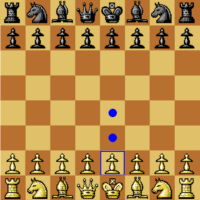
|
|
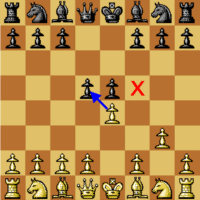
|
| |
|
|
|
Pawns move forward only and they cannot retreat. At the beginning of a game, each Pawn has the option to advance 1 or 2 squares. Afterwards, they can only move one square at a time. |
|
|
|
Pawns can capture in a diagonal way only as shown above. The e-4 Pawn cannot move forward because is blocked by the black e-5 Pawn nor he can move to d-5 since it is an illegal move.
|
|
|
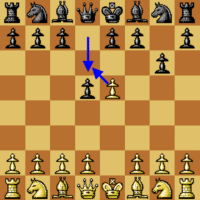 |
|
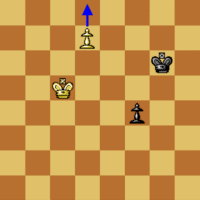 |
| |
|
|
|
Above, black Pawn just moved two squares to d-5. This enables the white Pawn to perform the optional en passant move by capturing it and placing himself onto the d-6 square (blue arrow). |
|
|
|
When a Pawn reaches the 8th rank, it can be promoted to any desired piece other than King or Pawn. The Queen is chosen as a natural and logic move for it's the most powerful Chess piece.
|
|
|
Notes: for more information on the usual Chess
Pawn, see Chesmayne illustrated rules of Chess or the
FIDE laws of Chess.
Pawn, historic remarks
With slightly different movement rules, the Pawn already appeared in the first variant of Chess, Chaturanga, about one-and-a-half millennium ago in India. At the period in the history of Europe that marked the end of the
middle ages and the start of the renaissance, movement of the Pawn was slightly changed: it gained its initial double step, and later en-passant capture, and different promotion rules were added.
More than any other minor piece, the Pawn is the Chess piece that is used as a metaphore: phrases like "He was just a Pawn in a Chess game" signify someone whose personal interests are sacrificed by others in a pursuit of other goals, referring to the Pawns role in a Chess game.
Pawn graphics
|